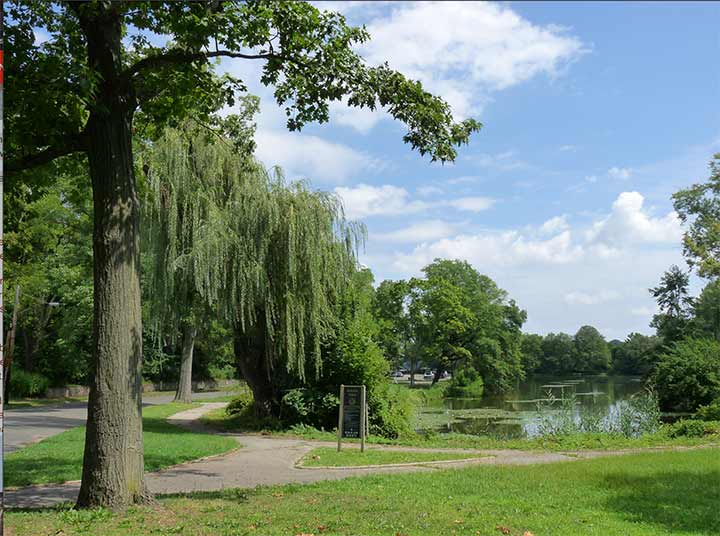
On the east end of 35th Avenue in Bayside, which oddly becomes a languidly curving route east of Corbett Road, is one of Bayside’s secrets, Golden Pond. An aged Henry Fonda and Katherine Hepburn could not be found, nor Jane Fonda in her bikini, though admittedly, it was October. Like Oakland Lake in Bayside Hills, Golden Pond is a shallow “kettle pond” left over from the Ice Age a few thousand years ago.
The park was named for John Golden (1874-1955), a longtime Bayside resident, Broadway producer, and showbiz patriarch. The park is the former grounds of his estate.
In 1916 [Golden] produced his first Broadway show, Turn to the Right. Following its tremendous success, Golden produced over 150 plays and musicals. These included The First Year, Three Wise Fools, and Lightnin’, which established a record (since broken repeatedly) of 1291 performances on Broadway. Golden also worked as a playwright and composer. Among the many musical numbers he wrote were “Poor Butterfly” and “Goodbye, Girls, I’m Through.”
Golden was an active statesman for the theatrical profession. During World Wars I and II he organized a free-ticket service for servicemen. Golden was one of the founders of the American Society of Composers, Authors, and Playwrights (ASCAP) in 1914 and served on the original Board of Directors of the City Center of Music and Drama. He was an eminent member of the theatrical fraternity known as the Lambs Club and served as “Shepherd” of that group from 1942 to 1944. Appointed the New York City Chairman for United Nations Day in 1954, Golden authored the “United Nations All Faith Prayer For Peace.”
He and his wife Margaret moved to Bayside in 1920 and subsequently made their estate available to the community. The well-maintained grounds were often used by neighborhood residents, including golf caddies practicing their swings, little leaguers playing baseball, and Sunday picnickers walking among the gardens. Some Bayside residents remember seeing Golden strolling in his white suit, broad-rimmed hat, and spats, carrying a silver-handled cane.
Upon his death on June 17, 1955, Golden’s will bequeathed his Bayside estate to the City of New York as a park “for the use and enjoyment by the young people of the community of all races and creeds in a manner similar to that in which I made this property available for recreation and community acts during my lifetime.” The dedication of John Golden Park took place on October 18, 1965. The speakers included Mayor Wagner, Robert Moses, Parks Commissioner Newbold Morris, department store owner Bernard F. Gimbel, President of Actors Equity Association Frederick O’Neal, cartoonist Rube Goldberg, comedian Harry Hershfield, and restaurateur Vincent Sardi Jr. [who is buried in Flushing Cemetery].
As always, “comment…as you see fit.” I earn a small payment when you click on any ad on the site.
10/20/22


6 comments
Is this the only naturally occurring kettle pond left?
Click the highlighted “More Queens Ponds” for the answer. As I’ve posted here before, the nine years I lived in the Alley Pond Co-op were among my best before retirement & relocation to AZ. If you absolutely must remain in NYC indefinitely seriously consider Bayside.
Don’t get me started on Hanoi Jane.
Urban legend says that the bikini got its name after the 1946 atomic bomb test at Bikini Atoll blew out the island’s middle while leaving the ends intact. Alas, reality is rather less amusing. While the swimsuit’s designer Louis Reard indeed named it after the island, he did so because he liked the sound of the name, not because of any geographic changes, In fact, the blast left a large crater but did not blow out the island’s middle.
Fun fact: in an example of career change, Reard was an automotive engineer but then decided to go into ladies’ clothing design.
Fun fact #2: Micheline Bernardini, who modeled the first bikini in 1946, is still alive in her 90’s.
WTF?! is this another example of loosened associations?
Is on old maps as “Mickle Pond” after Andrew Mickle, a mid-19th century landowner in Bayside who was a one-term mayor. His estate was between the Lawrence manor house and where Sacred Heart School and Church are today.